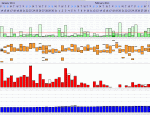Is it possible for 4cm Pressure to Totally Knock Out OSAs?
Is it possible for 4cm Pressure to Totally Knock Out OSAs?
Had a HOME sleep study done a couple of months ago that indicated an OSA of 20+ AHI (and no centrals). Have been using CPAP for the last 1-2 months, starting with a open 4-20cm APAP setting where the 95% pressure ranged between 7 to 9 cm, and the OSA went to almost zero but Clear Airway events (Central Apneas) ranged from 1.5 to 5.
At under 5, the Centrals may not be a huge concern to some people but it has been bugging me a lot because (a) i still wake up feeling tired, although a lot less than before CPAP therapy, and (b) no Centrals were noted in the initial sleep study, so it's strange for it to be a recurring issue now that the CPAP has managed to contain the OSAs detected from the sleep study.
I've shared lots of details in viewtopic.php?f=1&t=79766&p=728704#p728704, where it was suggested that i try to lower the pressure settings as a solution. My understanding is that high pressures can sometimes cause Centrals in their effort to reduce OSA events. Over the last few weeks, i've changed from APAP to CPAP and lowered the pressure to the minimum 4cm setting and i am still getting almost zero OSAs each night but Clear Airway Events between 1 and 3 (ie. a bit of a difference from when the pressure was at 7cm).
To get a better idea of what's causing these centrals, i'm scheduled to get a full sleep study (with EEG) to see how the central events are linked to my sleep staging. Each central event is almost always 10-15 seconds only and normally quite clustered, and after reading through most of the relevant threads in here, i'm no clearer as to their cause and what's the best way to get them treated, so i'm hoping the full sleep study will offer better insights.
As for the OSAs ... as per the question posed in the title of this thread, i'm wondering if the minimal 4cm pressure on CPAP is really able to completely solve the 20+ AHI OSA issue that was recorded in my initial home sleep study. There's a possibility that the sleep study was wrong and that i may not have OSA at all, and i guess the upcoming study will confirm this. But if i do ... then i'd really like to find out if it's possible for such a low pressure setting to turn 20+ obstructive events per hour to 0.
Thanks for sharing any thoughts and suggestions.
At under 5, the Centrals may not be a huge concern to some people but it has been bugging me a lot because (a) i still wake up feeling tired, although a lot less than before CPAP therapy, and (b) no Centrals were noted in the initial sleep study, so it's strange for it to be a recurring issue now that the CPAP has managed to contain the OSAs detected from the sleep study.
I've shared lots of details in viewtopic.php?f=1&t=79766&p=728704#p728704, where it was suggested that i try to lower the pressure settings as a solution. My understanding is that high pressures can sometimes cause Centrals in their effort to reduce OSA events. Over the last few weeks, i've changed from APAP to CPAP and lowered the pressure to the minimum 4cm setting and i am still getting almost zero OSAs each night but Clear Airway Events between 1 and 3 (ie. a bit of a difference from when the pressure was at 7cm).
To get a better idea of what's causing these centrals, i'm scheduled to get a full sleep study (with EEG) to see how the central events are linked to my sleep staging. Each central event is almost always 10-15 seconds only and normally quite clustered, and after reading through most of the relevant threads in here, i'm no clearer as to their cause and what's the best way to get them treated, so i'm hoping the full sleep study will offer better insights.
As for the OSAs ... as per the question posed in the title of this thread, i'm wondering if the minimal 4cm pressure on CPAP is really able to completely solve the 20+ AHI OSA issue that was recorded in my initial home sleep study. There's a possibility that the sleep study was wrong and that i may not have OSA at all, and i guess the upcoming study will confirm this. But if i do ... then i'd really like to find out if it's possible for such a low pressure setting to turn 20+ obstructive events per hour to 0.
Thanks for sharing any thoughts and suggestions.
_________________
| Mask: Mirage Quattro™ Full Face CPAP Mask with Headgear |
| Humidifier: S9™ Series H5i™ Heated Humidifier with Climate Control |
| Additional Comments: Sleepyhead Software |
Re: Is it possible for 4cm Pressure to Totally Knock Out OSAs?
Yes, it is possible for 4 cm pressure to effectively hold the airway open and prevent the collapse of the airway tissues that we call obstructive apneas or hyponeas.
It isn't related to the number of events you might have. It is related to the patency of your airway tissues.
You are lucky that 4 cm of pressure is sufficient.
The AHI is irrelevant in regards to pressure needed. Someone with an AHI of 8 might need 20 cm of pressure and someone with an HI of 90 might only need 5 cm. It isn't the number of events that dictates the pressure needs. Pressure needs are dictated by the airway tissues themselves...some are just more prone to collapse than others. Some are more easily held open with minimal pressures than others. Makes no difference if we are fat or skinny, male or female, high AHI or low AHI.....it is all in the airway tissues themselves.
It isn't related to the number of events you might have. It is related to the patency of your airway tissues.
You are lucky that 4 cm of pressure is sufficient.
The AHI is irrelevant in regards to pressure needed. Someone with an AHI of 8 might need 20 cm of pressure and someone with an HI of 90 might only need 5 cm. It isn't the number of events that dictates the pressure needs. Pressure needs are dictated by the airway tissues themselves...some are just more prone to collapse than others. Some are more easily held open with minimal pressures than others. Makes no difference if we are fat or skinny, male or female, high AHI or low AHI.....it is all in the airway tissues themselves.
_________________
| Machine: AirCurve™ 10 VAuto BiLevel Machine with HumidAir™ Heated Humidifier |
| Additional Comments: Mask Bleep Eclipse https://bleepsleep.com/the-eclipse/ |
I may have to RISE but I refuse to SHINE.
Re: Is it possible for 4cm Pressure to Totally Knock Out OSAs?
Is this total per night or hourly index?padster wrote: i am still getting almost zero OSAs each night but Clear Airway Events between 1 and 3
Either way it probably is not enough to warrant concern by most doctors. Especially if it is the total per night.
I had more than that show up in my last 30 minutes of sleep this morning. I was semi awake though. They don't count when you are semi awake.
_________________
| Machine: AirCurve™ 10 VAuto BiLevel Machine with HumidAir™ Heated Humidifier |
| Additional Comments: Mask Bleep Eclipse https://bleepsleep.com/the-eclipse/ |
I may have to RISE but I refuse to SHINE.
Re: Is it possible for 4cm Pressure to Totally Knock Out OSAs?
That makes a lot of sense, thanks for the quick response Pugsy.Pugsy wrote:Yes, it is possible for 4 cm pressure to effectively hold the airway open and prevent the collapse of the airway tissues that we call obstructive apneas or hyponeas.
It isn't related to the number of events you might have. It is related to the patency of your airway tissues.
You are lucky that 4 cm of pressure is sufficient.
The AHI is irrelevant in regards to pressure needed. Someone with an AHI of 8 might need 20 cm of pressure and someone with an HI of 90 might only need 5 cm. It isn't the number of events that dictates the pressure needs. Pressure needs are dictated by the airway tissues themselves...some are just more prone to collapse than others. Some are more easily held open with minimal pressures than others. Makes no difference if we are fat or skinny, male or female, high AHI or low AHI.....it is all in the airway tissues themselves.
_________________
| Mask: Mirage Quattro™ Full Face CPAP Mask with Headgear |
| Humidifier: S9™ Series H5i™ Heated Humidifier with Climate Control |
| Additional Comments: Sleepyhead Software |
Re: Is it possible for 4cm Pressure to Totally Knock Out OSAs?
That's an hourly index. The total events for a night range between 7 to 20 where the majority are frequently clustered in the middle of the night rather than during the onset of sleep or in the morning.Pugsy wrote:Is this total per night or hourly index?padster wrote: i am still getting almost zero OSAs each night but Clear Airway Events between 1 and 3
Either way it probably is not enough to warrant concern by most doctors. Especially if it is the total per night.
I had more than that show up in my last 30 minutes of sleep this morning. I was semi awake though. They don't count when you are semi awake.
It's not unusual for there to be 4 or 5 consecutive events (each about 12-15 seconds long) within about a 5 minute period. Do you know if there is anything we can read into such a pattern?
_________________
| Mask: Mirage Quattro™ Full Face CPAP Mask with Headgear |
| Humidifier: S9™ Series H5i™ Heated Humidifier with Climate Control |
| Additional Comments: Sleepyhead Software |
Re: Is it possible for 4cm Pressure to Totally Knock Out OSAs?
If you have the extra cash, you could check into getting a Zeo and possibly a Fit Bit. It might help to start to give context to some of the PAP data, especially if you line up the reports and try to nail down exactly when things go south. Neither device is 100% accurate, but neither is a PSG. I think the devices can be another tool in determining overall sleep health.
Also, any issues w/ RERA's? I don't see them mentioned in the post but they can be a mess to deal with. They seem to respond paradoxically to PAP so figuring out exactly where your pressure needs to be to stop them can be quite a process.
Also, any issues w/ RERA's? I don't see them mentioned in the post but they can be a mess to deal with. They seem to respond paradoxically to PAP so figuring out exactly where your pressure needs to be to stop them can be quite a process.
Re: Is it possible for 4cm Pressure to Totally Knock Out OSAs?
padster wrote:It's not unusual for there to be 4 or 5 consecutive events (each about 12-15 seconds long) within about a 5 minute period. Do you know if there is anything we can read into such a pattern?
I honestly don't know a clear cut answer to this question. If you were having them every hour...every night then we would look real close for maybe a Cheyenne Stokes Respiration pattern. Would need to look at the individual breaths up close though. If we saw it happen a lot then we worry.. but a random CSR pattern doesn't usually mean much.
This is what CSR really looks like.
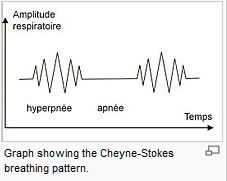
FWIW...unless your home study used thoracic belts along with EEG and breathing flow it is unlikely that it could even measure a true central. The zero centrals could simply be from the inability to flag them. Even our machines are limited to flow only data. They can't tell for sure either. We need to be asleep..and the machine doesn't know if we are asleep or not.
This example is handy. I would have to dig around to find a cluster similar within 5 minutes but I know I have had them. My overall AHI for last night was 2.76 and 1.84 of that was central index. I don't worry about that at all.
I had this show up right before I got up this morning. 5 centrals within a 15 minute period and I know I was semi awake during this time right before I finally got up out of bed.
Doesn't even come close to looking like true CSR. Showing the last section of events zoomed in closer each time.
So this is a rare occurrence for me...and I know that I was likely semi awake... so I don't even think about worrying about things when I see this sort of thing.
Even if it did look like CSR the fact that it is very rare for me means that it is not something I would need to worry about. Now if I saw this stuff every hour, all night long, every night...then I would worry.
If you are seeing similar clusters during times where sleep onset is likely present or like this one when waking up...maybe what you are seeing are semi awake events getting flagged.
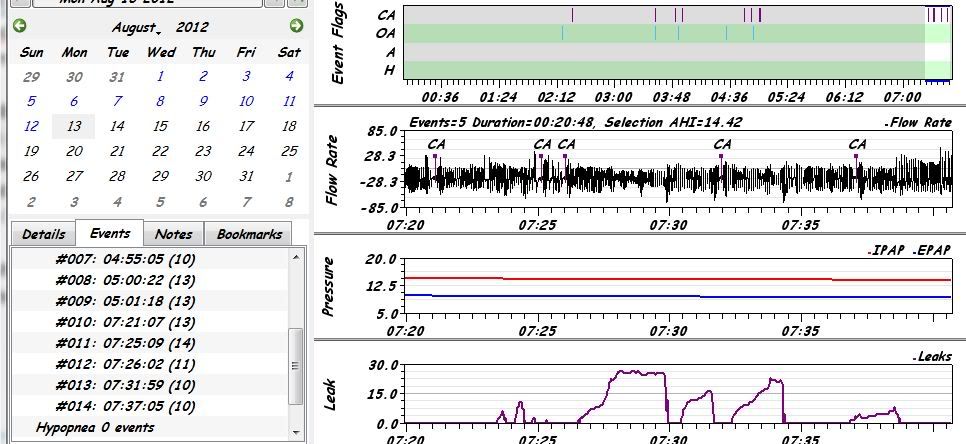
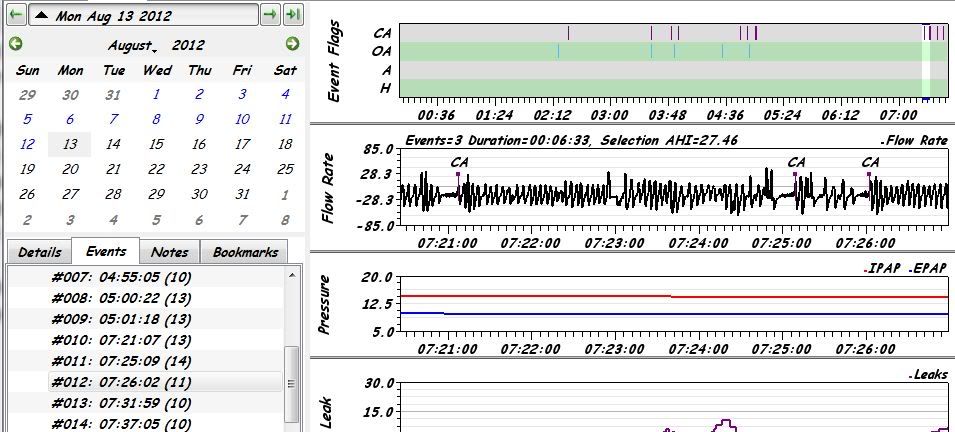
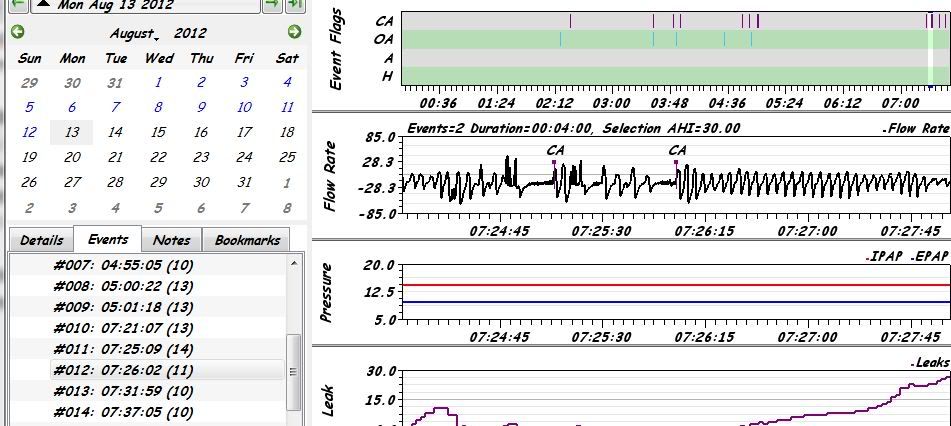
_________________
| Machine: AirCurve™ 10 VAuto BiLevel Machine with HumidAir™ Heated Humidifier |
| Additional Comments: Mask Bleep Eclipse https://bleepsleep.com/the-eclipse/ |
I may have to RISE but I refuse to SHINE.
- Lizistired
- Posts: 2835
- Joined: Tue Dec 14, 2010 10:47 pm
- Location: Indiana
Re: Is it possible for 4cm Pressure to Totally Knock Out OSAs?
Glad to hear you are getting a real study Padster!
I don't think you need to mess with a Zeo or anything else until you do that, other than watch for changes in the data.
Ask them for a copy of the full report and condensed graphs after your study. You will learn more from them than the home study and there will always be new questions after you think you have asked them all. You will also have the copy for a baseline.
The tech will know if your centrals are when you are waking up or messing with the mask. You may be having spontaneous arrousals disrupting your sleep stages.
You may very well not have obstructive apnea at all and then you can move on with finding out what really IS going on.
I don't think you need to mess with a Zeo or anything else until you do that, other than watch for changes in the data.
Ask them for a copy of the full report and condensed graphs after your study. You will learn more from them than the home study and there will always be new questions after you think you have asked them all. You will also have the copy for a baseline.
The tech will know if your centrals are when you are waking up or messing with the mask. You may be having spontaneous arrousals disrupting your sleep stages.
You may very well not have obstructive apnea at all and then you can move on with finding out what really IS going on.
_________________
| Humidifier: S9™ Series H5i™ Heated Humidifier with Climate Control |
| Additional Comments: Swift FX sometimes, CMS-50F, Cervical collar sometimes, White noise, Zeo... I'm not well, but I'm better. |
ResScan: http://www.resmed.com/int/assets/html/s ... c=patients
ResScan Tutorial- http://montfordhouse.com/cpap/resscan_tutorial/
Machines Video: http://www.cpaplibrary.com/machine-education
ResScan Tutorial- http://montfordhouse.com/cpap/resscan_tutorial/
Machines Video: http://www.cpaplibrary.com/machine-education
Re: Is it possible for 4cm Pressure to Totally Knock Out OSAs?
The best pressure(s), in the long run, is/are the pressure(s) that stabilize(s) your airway in a way that makes you feel most rested in the morning, not necessarily just about eliminating certain events--especially if you are particularly susceptible to sleep arousals from minor changes in your airway. Some docs believe that increasing pressure beyond what gets rid of apneas and hypopneas can sometimes be useful for those with mild OSA who tend more toward the UARS model of sleep-disturbed breathing. And for some of us, centrals increase temporarily until our brains get used to the pressure. Hopefully your sleep study will reveal some useful information about your particular circumstances--info that you and your team can use to try things that may help you. The main thing is not to give up but to be very vocal about the need for help to get the best sleep possible. It is worth the fight. And I agree that there is no need for a Zeo, especially not at this point for you. Unless, of course, you just feel like playing with a Zeo for sleep-hygiene suggestions, 'cause they can be a lot of fun!
-
Guest
Re: Is it possible for 4cm Pressure to Totally Knock Out OSAs?
padster wrote:Had a HOME sleep study done a couple of months ago that indicated an OSA of 20+ AHI (and no centrals). ................ There's a possibility that the sleep study was wrong and that i may not have OSA at all, and i guess the upcoming study will confirm this. But if i do ... then i'd really like to find out if it's possible for such a low pressure setting to turn 20+ obstructive events per hour to 0.
Thanks for sharing any thoughts and suggestions.
Can I ask if you are relatively young and not in too bad a shape? You sound "borderline" to me with regard to Sleep Apnea, and am wondering if you were to step up your daily exercising (vigorous walking or jogging) that you might be able to resolve all your sleep issues?
Re: Is it possible for 4cm Pressure to Totally Knock Out OSAs?
I agree that sometimes, increasing the minimum pressure may make you feel better even if AHI doesn't go down. I'm still experimenting with this, but I think it makes me feel better.jnk wrote:The best pressure(s), in the long run, is/are the pressure(s) that stabilize(s) your airway in a way that makes you feel most rested in the morning, not necessarily just about eliminating certain events--especially if you are particularly susceptible to sleep arousals from minor changes in your airway. Some docs believe that increasing pressure beyond what gets rid of apneas and hypopneas can sometimes be useful for those with mild OSA who tend more toward the UARS model of sleep-disturbed breathing. And for some of us, centrals increase temporarily until our brains get used to the pressure. Hopefully your sleep study will reveal some useful information about your particular circumstances--info that you and your team can use to try things that may help you. The main thing is not to give up but to be very vocal about the need for help to get the best sleep possible. It is worth the fight. And I agree that there is no need for a Zeo, especially not at this point for you. Unless, of course, you just feel like playing with a Zeo for sleep-hygiene suggestions, 'cause they can be a lot of fun!
I don't think jnk was suggesting it, but I will point out that you probably shouldn't lower your pressure if your AHI goes up much, even if you do feel better.
_________________
| Mask: Swift™ FX Nasal Pillow CPAP Mask with Headgear |
| Humidifier: S9™ Series H5i™ Heated Humidifier with Climate Control |
| Additional Comments: Also SleepyHead, PRS1 Auto, Respironics Auto M series, Legacy Auto, and Legacy Plus |
Please enter your equipment in your profile so we can help you.
Click here for information on the most common alternative to CPAP.
If it's midnight and a DME tells you it's dark outside, go and check for yourself.
Useful Links.
Click here for information on the most common alternative to CPAP.
If it's midnight and a DME tells you it's dark outside, go and check for yourself.
Useful Links.
Re: Is it possible for 4cm Pressure to Totally Knock Out OSAs?
Thanks, archangle. You are right that I did not mean to suggest lowering pressure and thereby increasing AHI. I meant that for some, increasing pressure beyond what gets rid of apneas and hypopneas may further stabilize the airway. I think that is the general idea behind some of the controversial approaches that were being tried by some in the high plains of the Southwest:archangle wrote:. . . I don't think jnk was suggesting it, but I will point out that you probably shouldn't lower your pressure if your AHI goes up much, even if you do feel better.
https://www.youtube.com/watch?v=_FrxWQBm3iQ
https://www.youtube.com/watch?v=JWm7tT-ZNzE
- Lizistired
- Posts: 2835
- Joined: Tue Dec 14, 2010 10:47 pm
- Location: Indiana
Re: Is it possible for 4cm Pressure to Totally Knock Out OSAs?
Padster was getting all centrals.
_________________
| Humidifier: S9™ Series H5i™ Heated Humidifier with Climate Control |
| Additional Comments: Swift FX sometimes, CMS-50F, Cervical collar sometimes, White noise, Zeo... I'm not well, but I'm better. |
ResScan: http://www.resmed.com/int/assets/html/s ... c=patients
ResScan Tutorial- http://montfordhouse.com/cpap/resscan_tutorial/
Machines Video: http://www.cpaplibrary.com/machine-education
ResScan Tutorial- http://montfordhouse.com/cpap/resscan_tutorial/
Machines Video: http://www.cpaplibrary.com/machine-education
Re: Is it possible for 4cm Pressure to Totally Knock Out OSAs?
As I understand it (which is probably wrong):Lizistired wrote:Padster was getting all centrals.
Significant centrals can only be noted in a PSG, not by a home machine.
And even if those clear-airway-marked events are actual centrals, the number of them is subclinical, right?
Events marked by a home machine as "clear airway" events can, at times, be the result of too low of a pressure, since an unstable airway leads to unstable breathing.
The patient was diagnosed OSA, not central apnea, as I understand it.
APAP is generally considered a lousy choice for reducing true centrals, if there are enough of them to bother gunning for them.
The purpose of my links was to show that some docs believe that It is possible for someone to have a form of OSA even when no, or few, obstructive events show up in the home-machine-counted (actually, estimated) AHI. Flattening, flow limitation, RERAs, UARS, etc can all disturb sleep without showing up regularly and clearly in the stats from a home machine. That is why lowering pressure to get rid of few centrals can, at times, be counterproductive for many patients with OSA. It isn't as simple as "oh, that clear-airway event is a central, so lower your pressure." Ever.
It can take the body a while to get used to the pressure so that the "centrals" go away. And if they don't, after a reasonable amount of time . . .
I agree that if a LARGE number of TRUE centrals continue after running at one solid CPAP pressure with no EPR for a few weeks, it may be necessary to find the cause of the centrals, which is generally considered more important than maiking them go away, if there is no proof they are disturbing sleep or desaturating the patient.
But, hey, I could be wrong. I often am.
I think this is another case proving the value of lab PSGs. It shows that lab PSGs save money in the long run.
http://www.stacommunications.com/journa ... df/109.pdf
Re: Is it possible for 4cm Pressure to Totally Knock Out OSAs?
Wow, thank you all so much for the fantastic responses. This community is truly amazing.
@themonk
Not too sure about RERA's. There was no mention of it in the initial Sleep Study report and i haven't done sufficient reading up on it yet. From another member's SleepHead screencapture in here, i noticed that there was a 'RERA reading' next to the area which displays the AHI/H/OA/CA readings, but there's nothing in mine. Maybe there's another device needed to capture the RERA data (like for O2 Sats) which is then imported into SleepHead as well to provide a consolidated picture as per the one i saw. Evidently, i'm a little lost on this and need to do more reading on RERA and UARS.
@Pugsy
@Lizistired
So, i hope what i'm going to get will still be considered a 'real study'. The provider assured me that the equipment used is exactly the same as the one used in the hospital, and that the end report produced will be identical. The only difference being the physical location and the absence of a tech to monitor me & the data in real time.
@jnk
@Guest/Sloop
@archangle
@jnk
@themonk
>> Yes, i'm thinking of getting a Zeo. There are reviews that question its overall accuracy and reliability but i guess it does offer another data source. However, i'm wondering whether the extra (potentially noisy) data will help to provide greater clarity on what's going on or end up confusing the situation further. Still thinking about it, so if anyone else has real positive or negative experience with using Zeo data to assist in Sleep Apnea management, do share your thoughts.If you have the extra cash, you could check into getting a Zeo and possibly a Fit Bit. It might help to start to give context to some of the PAP data, especially if you line up the reports and try to nail down exactly when things go south. Neither device is 100% accurate, but neither is a PSG. I think the devices can be another tool in determining overall sleep health.
Also, any issues w/ RERA's? I don't see them mentioned in the post but they can be a mess to deal with. They seem to respond paradoxically to PAP so figuring out exactly where your pressure needs to be to stop them can be quite a process.
Not too sure about RERA's. There was no mention of it in the initial Sleep Study report and i haven't done sufficient reading up on it yet. From another member's SleepHead screencapture in here, i noticed that there was a 'RERA reading' next to the area which displays the AHI/H/OA/CA readings, but there's nothing in mine. Maybe there's another device needed to capture the RERA data (like for O2 Sats) which is then imported into SleepHead as well to provide a consolidated picture as per the one i saw. Evidently, i'm a little lost on this and need to do more reading on RERA and UARS.
@Pugsy
>> My (home) Sleep Study report noted that there was no CSR issue, however, it wasn't a full PSG done in a lab. I'm not getting them every hour every night, so perhaps it's not a cause for concern. Thanks for your feedback.I honestly don't know a clear cut answer to this question. If you were having them every hour...every night then we would look real close for maybe a Cheyenne Stokes Respiration pattern. Would need to look at the individual breaths up close though. If we saw it happen a lot then we worry.. but a random CSR pattern doesn't usually mean much.
>> There was no EEG but there were belts strapped across my chest. Not sure if they were thoracic belts but i presume they were used to measure/detect chest/diaphragm movements. My upcoming test will include an EEG and the 'full works' as far as i'm aware.FWIW...unless your home study used thoracic belts along with EEG and breathing flow it is unlikely that it could even measure a true central.
>> That's good to hear. Those numbers are quite similar to mine.My overall AHI for last night was 2.76 and 1.84 of that was central index. I don't worry about that at all.
>> Agreed. When looking at the Event Flags, i tend to mentally discount the ones near to sleep onset and in the morning, thinking that they might be noisy and not a cause for concern. I'm generally trying to figure out what's causing the ones occurring between 2am and 5-6 am. Thanks for sharing your experience.If you are seeing similar clusters during times where sleep onset is likely present or like this one when waking up...maybe what you are seeing are semi awake events getting flagged.
@Lizistired
>> Hey Liz, i'll be getting a full sleep study but it's going to be done at home and without a tech observing me throughout the night. There are no Sleep Clinics where i live and i didn't want to stay in the hospital overnight to do the test, as i'm hugely averse to staying in hospitals for superstitious reasons and fear of hospital acquired infections.Glad to hear you are getting a real study Padster!
So, i hope what i'm going to get will still be considered a 'real study'. The provider assured me that the equipment used is exactly the same as the one used in the hospital, and that the end report produced will be identical. The only difference being the physical location and the absence of a tech to monitor me & the data in real time.
Well, this has been bugging me for weeks now. But from the feedback in this thread, it appears that the low 4cm pressure may indeed be able to knock out the OSAs detected in my first sleep study. So, i suppose this increases the chance of the sleep study being accurate. If the consensus was that there's no way 4cm is able to reduce 20+ OSA events per hour to zero, it would really indicate that the Sleep Study results were questionable. Anyway, i'll keep you posted on the results from my 'real study'You may very well not have obstructive apnea at all and then you can move on with finding out what really IS going on.
@jnk
>> Yes, i've heard many of the more experienced members mentioning that it's how you feel which is more important rather than the AHIs and numbers. I'm certainly feeling better after using a CPAP machine but haven't managed to experience that 'amazing feeling' that some people share, as i do still feel a little bit sleepy in the morning/afternoon at times. From what i've gathered, for some people, that amazing feeling may not come straight away and 1 month of CPAP usage may be too soon to pass judgement, so i'm now at about the 2+ month stage and i think its slowly getting better each day.The best pressure(s), in the long run, is/are the pressure(s) that stabilize(s) your airway in a way that makes you feel most rested in the morning, not necessarily just about eliminating certain events
>> Thanks for reconfirming this. Sometimes, we can be made to feel like we ask too many questions or are overly detailed (by some profit driven medical service providers) when trying to find answers on how to get the best sleep possible, so it's good to hear that it is worth the fight.The main thing is not to give up but to be very vocal about the need for help to get the best sleep possible. It is worth the fight.
@Guest/Sloop
>> Late 30's, reasonably good shape, exercise 2-4 times per week. In the last 2-3 months, i've been controlling diet, exercising more and focusing on lowering BMI to improve health and trying to resolve sleep problems. Overall, i'm feeling better (lower weight, lower blood pressure, less sleepiness), but i'm not sure if its due to the CPAP therapy, the improved health/lifestyle or a bit of both.Can I ask if you are relatively young and not in too bad a shape? You sound "borderline" to me with regard to Sleep Apnea, and am wondering if you were to step up your daily exercising (vigorous walking or jogging) that you might be able to resolve all your sleep issues?
@archangle
>> I presume you're referring to OSAs? Lowering the min pressure has made my AHI go down (as most of them are Centrals), and i think i feel better, but i'm not too sure as i do still feel sleepy on some days while others are perkier.I agree that sometimes, increasing the minimum pressure may make you feel better even if AHI doesn't go down. I'm still experimenting with this, but I think it makes me feel better.
I don't think jnk was suggesting it, but I will point out that you probably shouldn't lower your pressure if your AHI goes up much, even if you do feel better.
@jnk
>> Thanks for the link. As i shared above, i'm scheduled for a home PSG which is a Level 3 PSG as described in the PDF. I'm surprised to see that it "cannot measure sleep staging or arousals", as i was hoping that it could. I thought that the only difference was the presence of a tech for real time observational purposes. I thought sleep staging is monitored by the EEG, but perhaps there's more to it. I guess i need to do a lot more research but the link you shared has been a real eye opener. I notice it's a document from 2004 and am wondering if the effectiveness of different PSGs have evolved in the last 8 years since the information was published.It shows that lab PSGs save money in the long run. http://www.stacommunications.com/journa ... df/109.pdf
>> Spot on. I'm actually more concerned with the potential causes of the Centrals (to identify other health issues if any), if they actually are Centrals that i'm getting. I've stuck to a 4cm CPAP pressure for a few weeks now with no EPR, and get about 5 to 15 Clear Airway events every day and 0 to 2 OSA events. If these numbers are subclinical, then perhaps it's time to stop worrying about them. I guess its just the conflicting OSAs-vs-Centrals/Clear-Airway data in the SleepStudy vs results from CPAP therapy that's bugging me.I agree that if a LARGE number of TRUE centrals continue after running at one solid CPAP pressure with no EPR for a few weeks, it may be necessary to find the cause of the centrals, which is generally considered more important than maiking them go away
>> That's really interesting as it's exactly what i've been doing ie. "lowering pressure to get rid of few centrals". It's lowered my AHI and i think i feel better compared to when the pressure was at 7-9cm, but i hope it hasn't caused any undetected OSAs. Do you know what's the best way to figure out if a particular case is one where it's counterproductive to lower the pressure?The purpose of my links was to show that some docs believe that It is possible for someone to have OSA even when no events show up in the home-machine-counted (actually, estimated) AHI. Flattening, flow limitation, RERAs, UARS, etc can all disturb sleep without showing up regularly and clearly in the stats from a home machine. That is why lowering pressure to get rid of few centrals can, at times, be counterproductive for many patients with OSA. It isn't as simple as "oh, that clear-airway event is a central, so lower your pressure." Ever.
_________________
| Mask: Mirage Quattro™ Full Face CPAP Mask with Headgear |
| Humidifier: S9™ Series H5i™ Heated Humidifier with Climate Control |
| Additional Comments: Sleepyhead Software |









